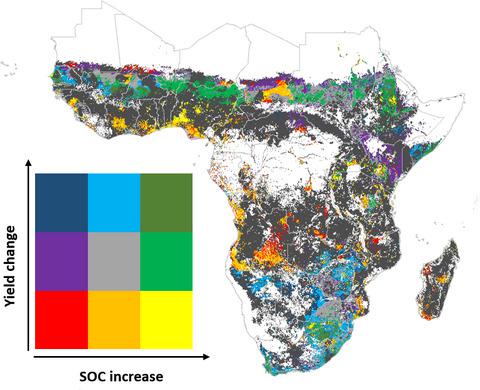当前位置:
X-MOL 学术
›
Glob. Change Biol.
›
论文详情
Our official English website, www.x-mol.net, welcomes your feedback! (Note: you will need to create a separate account there.)
The overlooked spatial dimension of climate-smart agriculture.
Global Change Biology ( IF 11.6 ) Pub Date : 2019-11-28 , DOI: 10.1111/gcb.14940 Reinhard Prestele 1 , Peter H Verburg 1, 2
Global Change Biology ( IF 11.6 ) Pub Date : 2019-11-28 , DOI: 10.1111/gcb.14940 Reinhard Prestele 1 , Peter H Verburg 1, 2
Affiliation

|
Climate-smart agriculture (CSA) and sustainable intensification (SI) are widely claimed to be high-potential solutions to address the interlinked challenges of food security and climate change. Operationalization of these promising concepts is still lacking and potential trade-offs are often not considered in the current continental- to global-scale assessments. Here we discuss the effect of spatial variability in the context of the implementation of climate-smart practices on two central indicators, namely yield development and carbon sequestration, considering biophysical limitations of suggested benefits, socioeconomic and institutional barriers to adoption, and feedback mechanisms across scales. We substantiate our arguments by an illustrative analysis using the example of a hypothetical large-scale adoption of conservation agriculture (CA) in sub-Saharan Africa. We argue that, up to now, large-scale assessments widely neglect the spatially variable effects of climate-smart practices, leading to inflated statements about co-benefits of agricultural production and climate change mitigation potentials. There is an urgent need to account for spatial variability in assessments of climate-smart practices and target those locations where synergies in land functions can be maximized in order to meet the global targets. Therefore, we call for more attention toward spatial planning and landscape optimization approaches in the operationalization of CSA and SI to navigate potential trade-offs.
中文翻译:

气候智能型农业被忽视的空间维度。
人们普遍认为,气候智能型农业(CSA)和可持续集约化(SI)是解决粮食安全和气候变化相互关联的挑战的高潜力解决方案。这些有前途的概念仍然缺乏可操作性,在目前的大陆到全球规模的评估中,通常不会考虑潜在的取舍。在这里,我们讨论了在实施气候智能措施的背景下空间可变性对两个主要指标的影响,即产量发展和碳固存,考虑了建议收益的生物物理局限性,采用的社会经济和制度障碍以及跨规模的反馈机制。我们以撒哈拉以南非洲假设大规模采用保护性农业为例,通过说明性分析来证实我们的论点。我们认为,到目前为止,大规模评估广泛忽略了气候智能做法在空间上的影响,导致人们对农业生产的共同利益和减缓气候变化潜力的说法过分夸大。迫切需要在评估气候智能做法时考虑到空间变异性,并针对那些可以最大程度发挥土地功能协同作用以实现全球目标的地点。因此,我们呼吁在CSA和SI的运营中更加关注空间规划和景观优化方法,以权衡潜在的取舍。大规模评估广泛忽略了气候智能做法在空间上的影响,导致人们夸大了关于农业生产的共同利益和减缓气候变化潜力的陈述。迫切需要在评估气候智能做法时考虑到空间变异性,并针对那些可以最大程度发挥土地功能协同作用以实现全球目标的地点。因此,我们呼吁在CSA和SI的运营中更加关注空间规划和景观优化方法,以权衡潜在的取舍。大规模评估广泛忽略了气候智能做法在空间上的影响,导致人们夸大了关于农业生产的共同利益和减缓气候变化潜力的陈述。迫切需要在评估气候智能做法时考虑到空间变异性,并针对那些可以最大程度发挥土地功能协同作用以实现全球目标的地点。因此,我们呼吁在CSA和SI的运营中更加关注空间规划和景观优化方法,以权衡潜在的取舍。迫切需要在评估气候智能做法时考虑到空间变异性,并针对那些可以最大程度发挥土地功能协同作用以实现全球目标的地点。因此,我们呼吁在CSA和SI的运营中更加关注空间规划和景观优化方法,以权衡潜在的取舍。迫切需要在评估气候智能做法时考虑到空间变异性,并针对那些可以最大程度发挥土地功能协同作用以实现全球目标的地点。因此,我们呼吁在CSA和SI的运营中更加关注空间规划和景观优化方法,以权衡潜在的取舍。
更新日期:2020-01-13
中文翻译:

气候智能型农业被忽视的空间维度。
人们普遍认为,气候智能型农业(CSA)和可持续集约化(SI)是解决粮食安全和气候变化相互关联的挑战的高潜力解决方案。这些有前途的概念仍然缺乏可操作性,在目前的大陆到全球规模的评估中,通常不会考虑潜在的取舍。在这里,我们讨论了在实施气候智能措施的背景下空间可变性对两个主要指标的影响,即产量发展和碳固存,考虑了建议收益的生物物理局限性,采用的社会经济和制度障碍以及跨规模的反馈机制。我们以撒哈拉以南非洲假设大规模采用保护性农业为例,通过说明性分析来证实我们的论点。我们认为,到目前为止,大规模评估广泛忽略了气候智能做法在空间上的影响,导致人们对农业生产的共同利益和减缓气候变化潜力的说法过分夸大。迫切需要在评估气候智能做法时考虑到空间变异性,并针对那些可以最大程度发挥土地功能协同作用以实现全球目标的地点。因此,我们呼吁在CSA和SI的运营中更加关注空间规划和景观优化方法,以权衡潜在的取舍。大规模评估广泛忽略了气候智能做法在空间上的影响,导致人们夸大了关于农业生产的共同利益和减缓气候变化潜力的陈述。迫切需要在评估气候智能做法时考虑到空间变异性,并针对那些可以最大程度发挥土地功能协同作用以实现全球目标的地点。因此,我们呼吁在CSA和SI的运营中更加关注空间规划和景观优化方法,以权衡潜在的取舍。大规模评估广泛忽略了气候智能做法在空间上的影响,导致人们夸大了关于农业生产的共同利益和减缓气候变化潜力的陈述。迫切需要在评估气候智能做法时考虑到空间变异性,并针对那些可以最大程度发挥土地功能协同作用以实现全球目标的地点。因此,我们呼吁在CSA和SI的运营中更加关注空间规划和景观优化方法,以权衡潜在的取舍。迫切需要在评估气候智能做法时考虑到空间变异性,并针对那些可以最大程度发挥土地功能协同作用以实现全球目标的地点。因此,我们呼吁在CSA和SI的运营中更加关注空间规划和景观优化方法,以权衡潜在的取舍。迫切需要在评估气候智能做法时考虑到空间变异性,并针对那些可以最大程度发挥土地功能协同作用以实现全球目标的地点。因此,我们呼吁在CSA和SI的运营中更加关注空间规划和景观优化方法,以权衡潜在的取舍。


























 京公网安备 11010802027423号
京公网安备 11010802027423号